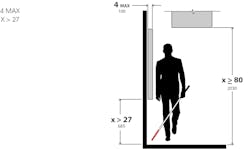With technology continually improving, one of the best ways to apply it is in ways that make our lives easier.
Certainly that’s often the goal with most technologies, yet with travel being one of the most stressful experiences for folks, streamlining the process is ever so important.
By utilizing digital signage both indoors and outdoors, for example, facilities can reduce perceived wait times, utilize wait times to share information, and ease travel with directional signage and trip updates, leading to increased customer satisfaction.
When the Washington Metropolitan Area Transit Authority (Metro) updated the rail transit system’s digital signage, Metro Design Engineer Robert DelCoco said, “We want[ed] to equip Metro riders with all the information they need to get to their destinations on time. Providing that information at the station before customers swipe their farecard is an important addition to our other communications outreach.”
Ron Cameron, senior technology deployment project lead at the Utah Transit Authority (UTA), echoed this sentiment when implementing weatherproof outdoor LED (dot matrix) signs along UTA’s light rail and commuter rail platforms. Cameron stated, “We wanted something with a good back end so that we could send out ad hoc messages when we had to put bus bridges in place because of an accident the train wasn’t able to proceed to a station so we would put messages up on these signs from our customer service center.”
Providing information to both customers and staff is tantamount for transit agencies. Yet, to experience the rewards of customer and employee satisfaction, special considerations surrounding digital signage integrations must be made.
Outdoor Displays
Outdoor displays are seen everywhere in transportation applications, which makes displaying information easier than it has ever been. From real-time arrival and departure information at the train station to digital advertising at the bus stop to directional information at the subway station, outdoor displays have become key to both customers and staff at transportation agencies.
Christopher Freeman, technology architect at United Airlines, has noted that Chicago O’Hare International Airport is in the process of updating its directional outdoor signage at its airline gates to true LED solutions, making it easier for pilots and on-the-ground staff to be aware of aircraft details and luggage management. This, in turn, makes the deplaning process smoother for travelers.
This emerging technology has brought many benefits to the public transit industry and will continue to further enhance the customer experience.
However, before choosing and installing outdoor displays, it is crucial to remember that digital displays deployed outdoors are subject to the elements 24/7. It’s important to consider the following factors and how they will affect the outdoor digital display.
Transit outdoor displays must:
- Be designed to withstand a fluctuation of temperatures (all-season solution)
- Be designed to withstand high temperatures and direct sunlight for long periods of time
- Have a fully sealed design to prevent water, dust, or insects from entering the display
- Have an ambient light sensor to automatically adjust the display’s brightness
- Have internal cooling and warming system to keep inside components at the proper temperature
- Be designed for excessive shock/vibration that is caused by passing trains/buses
- Be able to withstand high winds (both the display and mounting solution)
- Have an anti-reflective and impact-resistant safety glass to prevent sun glare and damage
Indoor Displays & Applications
The entryways to train stations and airports tend to receive the most traffic of any spot. These locations are where guests check in and out, where they enter and exit the airport, and oftentimes, where they meet their friends, family and co-workers. Therefore, these spots are the perfect places to share pertinent information with guests. However, getting a visitor’s attention with so much going on can be difficult. Through eye-catching displays and consistently changing content, though, digital signage meets this need, providing travelers with up-to-date travel information for a seamless experience. They can also be used to provide ticketing, navigation, emergency alerts and entertainment.
Additionally, implementing wayfinding and self-service kiosks allows travelers to check themselves in, print tickets, locate facilities and much more. The kiosks also enhance the customer experience, reduce staffing costs and more efficiently utilize resources.
Technology is ever-changing and communications and services must keep up with the times. Today, it’s hard to find someone who does not have some type of mobile device on them at all times. By developing an application or incorporating mobile integration, the convenience factor is even more prevalent and valuable to the traveler, especially at airports. Benefits like checking in and out, checking flight information, submitting a cancellation, and requesting services become readily available and especially faster when they are right at your fingertips.
ADA Compliance
In 1990, the Americans with Disabilities Act (ADA) was signed into law to prohibit discrimination and ensure equal access and opportunity for those with mental and physical disabilities in the areas of employment, public entities, public accommodations, commercial facilities, telecommunications and more.
In 2010, additional provisional regulations were signed into effect to revise the area of accessible design, enhancing the lifestyles of the more than 54 million Americans with disabilities. These regulations ensure that public spaces have, among other accessibility features, clear pathways and curbed ramps.
For transit settings, this law affects the planning of many digital signage applications — from kiosks that sell tickets to video wall displays, to name a few. For example, video walls that are between 27 inches and 80 inches off the floor must be less than 4 inches off the walk to allow for the visually impaired to easily walk past.
In the past with large and bulky displays, ensuring compliance in this area was a bit more complicated. Most often, this required integrators to recess displays into the wall, which took more time and was often more complicated and expensive. Now, displays are getting slimmer and lighter.
ADA regulations also apply to the construction and functionality of digital signage kiosks. For example, if your device has touch features, the maximum height allowed off the ground is 48 inches, with a maximum reach of 10 inches. A reach larger than this requires a shorter kiosk.
With enhanced technology, integrating ADA-compliant kiosks has become easier. Advanced IR sensors are used to determine height and cater the placement of touch items on displays in accordance with ADA regulations.
A multitude of additional options exist for compliance in digital signage, including voice responsive software, Braille keyboards and tactile signs.
Once the aforementioned have been considered, the true takeaway here is the numerous opportunities for functions of digital signage in transit settings. Digital signage can be used to generate revenue through advertising, provide personalized guest service and wayfinding, communicate with travelers, and more. With advanced audio-visual solutions, we can now create a 360-degree travel experience, allowing customers to interact with transit providers anywhere, at any time of day. A constant stream of fresh content on-demand is the expectation these days and it is through digital signage that transit agencies can truly accomplish superb communication with customers.
Jack McKeague is the general manager and vice president of sales – Display Division at Peerless-AV.




